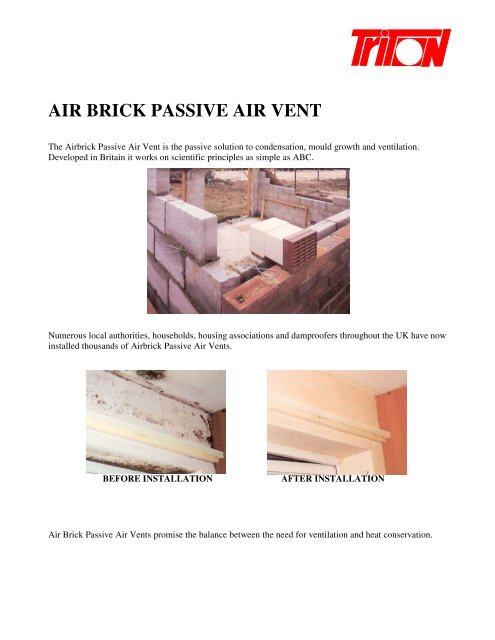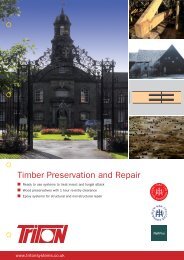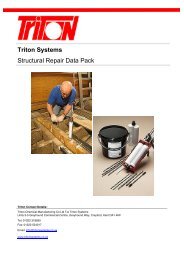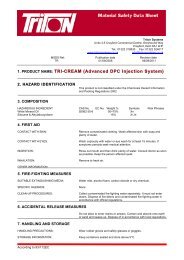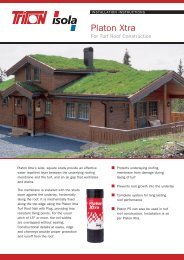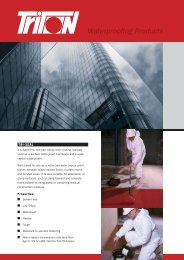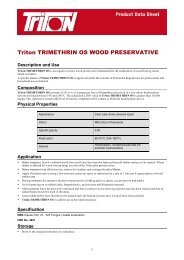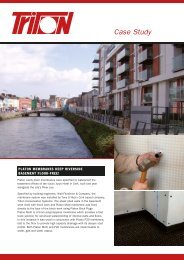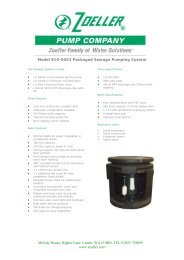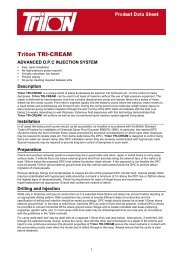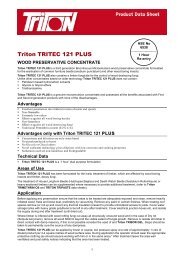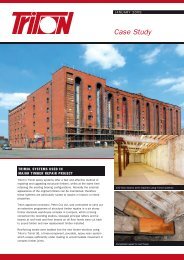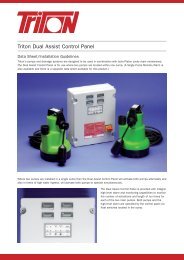Data air brick passive air vent - Triton
Data air brick passive air vent - Triton
Data air brick passive air vent - Triton
Create successful ePaper yourself
Turn your PDF publications into a flip-book with our unique Google optimized e-Paper software.
AIR BRICK PASSIVE AIR VENT<br />
The Air<strong>brick</strong> Passive Air Vent is the <strong>passive</strong> solution to condensation, mould growth and <strong>vent</strong>ilation.<br />
Developed in Britain it works on scientific principles as simple as ABC.<br />
Numerous local authorities, households, housing associations and damproofers throughout the UK have now<br />
installed thousands of Air<strong>brick</strong> Passive Air Vents.<br />
BEFORE INSTALLATION AFTER INSTALLATION<br />
Air Brick Passive Air Vents promise the balance between the need for <strong>vent</strong>ilation and heat conservation.
KEY FEATURES<br />
• Transparent to water vapour<br />
• No moving parts<br />
• Works <strong>passive</strong>ly 24 hours per day<br />
• Makes no noise<br />
• Can be installed in approximately one hour<br />
1<br />
SPECIFICATIONS<br />
BENEFITS<br />
• Reduces draughty <strong>air</strong> flow and heat loss<br />
• No Running Costs<br />
• Minimal maintenance<br />
• Works at peak condensation time<br />
• No night time disturbances from compressors<br />
or fans<br />
• Low installation costs<br />
PRINCIPLE OF CONDENSATION CONTROL<br />
1. The production of moisture-laden <strong>air</strong> within a building results in a higher vapour pressure than outside.<br />
If there is an opening through which the moisture vapour can escape (being naturally inclined to move<br />
from high to low pressure) then condensation will be alleviated.<br />
2. The mineral fibre core of the <strong>vent</strong> is transparent to moisture vapour whilst at the same time it stifles<br />
draughts. Air still passes through but in a calm, draught-free way.<br />
3. The constant, self-regulating movement of moisture vapour by diffusion ensures that the risk of<br />
condensation, whatever the environmental conditions, is significantly reduced.<br />
SITING OF VENTS<br />
1. Four of the <strong>vent</strong>s positioned at ceiling height, two in each of the opposite facades on the ground floor,<br />
should provide a cross-flow sufficient for the average two or three bedroomed property. “Out of the<br />
way” rooms could be considered for an additional <strong>vent</strong>.<br />
2. The <strong>vent</strong>s occupy the space of a normal 9” x 6” <strong>air</strong><strong>brick</strong> (which is supplied as the external facing part of<br />
the <strong>vent</strong>).<br />
3. Full installation instructions are supplied with each <strong>vent</strong>.<br />
TUBE THICKNESS 3mm<br />
MAIN TUBE WIDTH 206mm<br />
MAIN TUBE HEIGHT 126 to 136mm<br />
MAIN TUBE LENGTH (OPEN) 340mm<br />
MAIN TUBE LENGTH (CLOSED) 240mm<br />
To fit 230mm x 155mm aperture (i.e. standard 9” x 6” <strong>air</strong><strong>brick</strong>)<br />
All sizes quoted are to the nearest millimetre<br />
TRITON CHEMICAL MANUFACTURING CO LTD<br />
Unit 5 Lyndean Industrial Estate, 129 Felixstowe Road<br />
Abbey Wood, London SE2 9SG<br />
Tel: 020 8310 3929 Fax: 020 8312 0349 Ref: 02/02 DATA.AIR BRICK PASSIVE AIR VENT<br />
Web: www.triton-chemicals.com<br />
Email: info@triton-chemicals.com<br />
2


